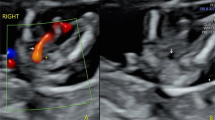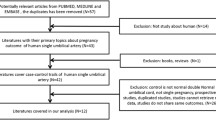Abstract
Objective
To evaluate perinatal outcome of fetuses with isolated single umbilical artery (SUA), and specifically to examine whether an isolated SUA is an independent risk factor for perinatal mortality.
Methods
A population-based study was conducted, comparing pregnancies of women with and without SUA. Deliveries occurred between the years 1988–2006, in a tertiary medical center. Multiple gestations, chromosomal abnormalities and malformations were excluded from the analysis. Stratified analysis was performed using multiple logistic regression models to evaluate the association between SUA and perinatal mortality, while controlling for confounders.
Results
Out of 194,809 deliveries, 243 (0.1%) were of fetuses with isolated SUA. Fetuses with SUA were smaller (2,844 ± 733 vs. 3,197 ± 530 g, P < 0.001), and were delivered at an earlier gestational age (38.3 ± 3.0 vs. 39.3 ± 2.1 weeks, P < 0.001), when compared with fetuses with normal umbilical vessels. Mothers to fetuses with isolated SUA tended to have a history of infertility treatments (4.5 vs. 1.7%; P = 0.001) when compared with the comparison group. Fetuses with SUA had more complications, including fetal growth restriction (FGR 9.5 vs. 1.9%, P < 0.001), polyhydramnios (11.5 vs. 3.7%; P < 0.001) and oligohydramnios (6.6 vs. 2.2%; P < 0.001). Deliveries of SUA fetuses had higher rates of placental abruption (3.3 vs. 0.7%; P < 0.001), placenta previa (1.2 vs. 0.4%; P = 0.03) and cord prolapse (2.9 vs. 0.4%; P < 0.001). Higher rates of cesarean deliveries were noted in this group (23.9 vs. 12.2%; P < 0.001). SUA newborns had higher rates of low Apgar scores (<7) in one (11.8 vs. 3.7%; P < 0.001) and 5 min (3.5 vs. 0.4%; P < 0.001). Higher rates of perinatal mortality were noted in the SUA group, as compared to fetuses with normal umbilical vessels (6.6 vs. 0.9%, OR 7.78; 95% CI 4.7–13.0; P < 0.001). Using a multiple logistic regression model, controlling for possible confounders, such as FGR, oligohydramnios, polyhydramnios, prolapse of cord, maternal hypertension and diabetes mellitus, isolated SUA remained an independent risk factor for perinatal mortality (adjusted OR = 3.91, 95% CI 2.06–7.43; P < 0.001).
Conclusion
Isolated SUA in our population was noted as an independent risk factor for perinatal mortality.
Similar content being viewed by others
References
Prucka S, Clemens M, Craven C, McPherson E (2004) Single umbilical artery: what does it mean for the fetus? A case–control analysis of pathologically ascertained cases. Genet Med 6:54–57
Csécsei K, Kovács T, Hinchliffe SA, Papp Z (1993) Incidence and associations of single umbilical artery in prenatally diagnosed malformed, midtrimester fetuses: a review of 62 cases. Am J Med Genet 46(2):248–249
Persutte WH, Hobbins J (1995) Single umbilical artery: a clinical enigma in modern prenatal diagnosis. Ultrasound Obstet Gynecol 6(3):216–229
Romero R, Pilu G, Jeanty P, Ghidini A, Hobbins JC (eds) (1988) Prenatal diagnosis of congenital anomalies. Appleton & Lange, Norwalk
Tanimura T, Ezaki KI (1968) Single umbilical artery found in Japanese embryos. Proc Congenit Anom Res Assoc Jpn 8:27
Predanic M, Perni SC, Friedman A, Chervenak FA, Chasen ST (2005) Fetal growth assessment and neonatal birth weight in fetuses with isolated single umbilical artery. Obstet Gynecol 105:1093–1097
Catanzarite VA, Hendricks SK, Maida C, Westbrook C, Cousins L, Schrimmer D (1995) Prenatal diagnosis of the two vessel cord: implications for patient counseling and obstetric management. Ultrasound Obstet Gynecol 5:98–105
Jauniaux E, De Munter C, Pardou A, Elkhazen N, Rodesch F, Wilkin P (1989) Evaluation echographique du syndrome de l’artere ombilicale unique: une serie de 80 cas. J Gynecol Obstet Biol Reprod 18:341–348
Leung AKC, Robson WLM (1989) Single umbilical artery: a report of 159 cases. Am J Dis Child 143:108–111
Thummala MR, Raju TN, Langenberg P (1998) Isolated single umbilical artery anomaly and the risk for congenital malformations: a meta-analysis. J Pediatr Surg 33(4):580–585
Doornebal N, de Vries TW, Bos AF, de Vries NK (2007) Screening infants with an isolated single umbilical artery for renal anomalies: nonsense? Early Hum Dev 83(9):567–570
Hershkovitz R, Sheiner E, Mazor M (2006) Middle cerebral artery blood flow velocimetry among healthy fetuses with a single umbilical artery. J Ultrasound Med 25(11):1405–1408
Bombrys AE, Neiger R, Hawkins S, Sonek J, Croom C, McKenna D, Ventolini G, Habli M, How H, Sibai B (2008) Pregnancy outcome in isolated single umbilical artery. Am J Perinatol 25(4):239–242
Maternal-Placental-Fetal Unit (2007) Fetal and early neonatal physiology. In: Decherney AH, Goodwin TM, Nathan L, Laufer N (eds) Current diagnosis and treatment OBS & GYN. McGraw-Hill, New York, p 170
Mu SC, Lin CH, Chen YL, Sung TC, Bai CH, Jow GM (2008) The perinatal outcomes of asymptomatic isolated single umbilical artery in full-term neonates. Pediatr Neonatol 49(6):230–233
Deshpande SA, Jog S, Watson H, Gornall A (2009) Do babies with isolated single umbilical artery need routine postnatal renal ultrasonography? Arch Dis Child Fetal Neonatal Ed 94(4):F265–F267 [Epub 8 Jan 2009]
Conflict of interest statement
None.
Author information
Authors and Affiliations
Corresponding author
Rights and permissions
About this article
Cite this article
Burshtein, S., Levy, A., Holcberg, G. et al. Is single umbilical artery an independent risk factor for perinatal mortality?. Arch Gynecol Obstet 283, 191–194 (2011). https://doi.org/10.1007/s00404-009-1326-3
Received:
Accepted:
Published:
Issue Date:
DOI: https://doi.org/10.1007/s00404-009-1326-3




